Erotic art

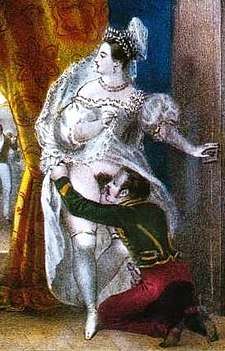
Erotic art covers any artistic work that is intended to evoke erotic arousal or that depicts scenes of sexual activity. It is a type of erotica and includes drawings, engravings, films, paintings, photographs, and sculptures, and writing.
Definition
The definition of erotic art is somewhat subjective, and dependent on context, since perceptions of both what is erotic and what is art vary. For example, a sculpture of a phallus in some cultures may be considered a traditional symbol of potency rather than overtly erotic. Material that is produced to illustrate sex education may be perceived by others as inappropriately erotic.
A distinction is often made between erotic art and pornography, which also depicts scenes of sexual activity and is intended to evoke erotic arousal, but is not usually considered fine art. Some draw a distinction based on the work's intent and message: erotic art would be works intended for purposes in addition to arousal, which could be appreciated as art by someone uninterested in their erotic content. US Supreme Court Justice Potter Stewart famously wrote that the distinction was intuitive, saying about hard-core pornography which would not be legally protected as erotic art, "I know it when I see it"[1]
Historical
Among the oldest surviving examples of erotic depictions are Paleolithic cave paintings and carvings, but many cultures have created erotic art. Artifacts have been discovered from ancient Mesopotamia depicting explicit heterosexual sex.[2][3] Glyptic art from the Sumerian Early Dynastic Period frequently shows scenes of frontal sex in the missionary position.[2] In Mesopotamian votive plaques from the early second millennium BC, the man is usually shown entering the woman from behind while she bends over, drinking beer through a straw.[2] Middle Assyrian lead votive figurines often represent the man standing and penetrating the woman as she rests on top of an altar.[2] Scholars have traditionally interpreted all these depictions as scenes of ritual sex,[2] but they are more likely to be associated with the cult of Inanna, the goddess of sex and prostitution.[2] Many sexually explicit images were found in the temple of Inanna at Assur,[2] which also contained models of male and female sexual organs,[2] including stone phalli, which may have been worn around the neck as an amulet or used to decorate cult statues,[2] and clay models of the female vulva.[2]
Depictions of sexual intercourse were not part of the general repertory of ancient Egyptian formal art,[4] but rudimentary sketches of heterosexual intercourse have been found on pottery fragments and in graffiti.[4] The Turin Erotic Papyrus (Papyrus 55001) is a 8.5 feet (2.6 m) by 10 inches (25 cm) Egyptian papyrus scroll discovered at Deir el-Medina,[5][4] the last two-thirds of which consist of a series of twelve vignettes showing men and women in various sexual positions.[5] The men in the illustrations are "scruffy, balding, short, and paunchy" with exaggeratedly large genitalia[6] and do not conform to Egyptian standards of physical attractiveness,[6][4] but the women are nubile[6][4] and they are shown with objects from traditional erotic iconography, such as convolvulus leaves and, in some scenes, they are even holding items traditionally associated with Hathor, the goddess of love, such as lotus flowers, monkeys, and sistra.[6][4] The scroll was probably painted in the Ramesside period (1292-1075 BC)[5] and its high artistic quality indicates that was produced for a wealthy audience.[5] No other similar scrolls have yet been discovered.[4]
The ancient Greeks painted sexual scenes on their ceramics, many of them famous for being some of the earliest depictions of same-sex relations and pederasty, and there are numerous sexually explicit paintings on the walls of ruined Roman buildings in Pompeii. The Moche of Peru in South America are another ancient people that sculpted explicit scenes of sex into their pottery.[7] There is an entire gallery devoted to pre-Columbian erotic ceramics (Moche culture) in Lima at the Larco Museum.
Additionally, there has been a long tradition of erotic painting in Eastern cultures. In Japan, for example, shunga appeared in the 13th century and continued to grow in popularity until the late 19th century when photography was invented.[8] Similarly, the erotic art of China reached its popular peak during the latter part of the Ming Dynasty.[9] In India, the famous Kama Sutra is an ancient sex manual that is still popularly read throughout the world.[10]
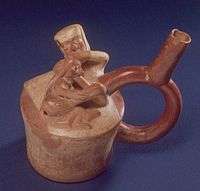
In Europe, starting with the Renaissance, there was a tradition of producing erotica for the amusement of the aristocracy. In the early 16th century, the text I Modi was a woodcut album created by the designer Giulio Romano, the engraver Marcantonio Raimondi and the poet Pietro Aretino. In 1601 Caravaggio painted the "Amor Vincit Omnia," for the collection of the Marquis Vincenzo Giustiniani.
An erotic cabinet, ordered by Catherine the Great, seems to have been adjacent to her suite of rooms in the Gatchina Palace. The furniture was highly eccentric with tables that had large penises for legs. Penises and vaginas were carved on the furniture. The walls were covered in erotic art. The rooms and the furniture were seen in 1941 by two Wehrmacht-officers but they seem to have vanished since then.[11][12] A documentary by Peter Woditsch suggests that the cabinet was in the Peterhof Palace and not in Gatchina.[13]
The tradition was continued by other, more modern painters, such as Fragonard, Courbet, Millet, Balthus, Picasso, Edgar Degas, Toulouse-Lautrec and Egon Schiele. Schiele served time in jail and had several works destroyed by the authorities for offending contemporary mores with his depictions of nude girls.
By the 20th century, photography became the most common medium for erotic art. Publishers like Taschen mass-produced erotic illustrations and erotic photography.
Modern
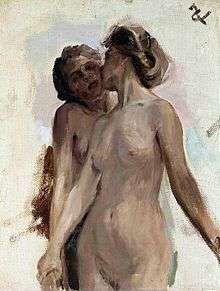
Today, erotic artists thrive, although in some circles, much of the genre is still not as well accepted as the more standard genres of art such as portraiture and landscape. During the last few centuries, society has broadened its view of what can be considered as art and several new styles developed during the 19th century such as Impressionism and Realism. This has given today's artists a broad variety of genres from which to choose, including; fantasy, pinup, horror, fetish, comics, anime, hentai, and many other niche genres all with erotic elements.
Classic "war-era" pin-ups like the works of Alberto Vargas, Gil Elvgren and Baron Von Lind, are still as popular as their contemporaries: Bunny Yeager, Greg Hildebrandt, Olivia De Berardinis, Hajime Sorayama, Alain Aslan, and others.
The acceptance and popularity of erotic art has pushed the genre into mainstream pop-culture and has created many famous icons. Frank Frazetta, Luis Royo, Boris Vallejo, Chris Achilleos, and Clyde Caldwell are among the artists whose work has been widely distributed. The Guild of Erotic Artists were formed in 2002 to bring together a body of like minded individuals whose sole purpose was to express themselves and promote the sensual art of erotica for the modern age.[14]
Between 2010 and 2015 sexologist and gallerist Laura Henkel, curator of the Erotic Heritage Museum and the Sin City Gallery, organised 12 Inches of Sin, an exhibition focussing on art that expresses a diverse view of sexuality and challenging ideas of high and low art.[15] In 2015 Henkel collaborated with former MoMA curator and art historian Rosa JH Berland to create the Modern Provocateur Manifesto, that describes artwork that is about human sexuality.
Legal standards
Whether or not an instance of erotic art is obscene depends on the standards of the jurisdisction and community in which it is displayed.
In the United States, the 1973 ruling of the Supreme Court of the United States in Miller v. California established a three-tiered test to determine what was obscene—and thus not protected, versus what was merely erotic and thus protected by the First Amendment.
Delivering the opinion of the court, Chief Justice Warren Burger wrote,
The basic guidelines for the trier of fact must be: (a) whether 'the average person, applying contemporary community standards' would find that the work, taken as a whole, appeals to the prurient interest, (b) whether the work depicts or describes, in a patently offensive way, sexual conduct specifically defined by the applicable state law; and (c) whether the work, taken as a whole, lacks serious literary, artistic, political, or scientific value.[16]
As this is still much more vague than other judicial tests within U.S. jurisprudence, it has not reduced the conflicts that often result, especially from the ambiguities concerning what the "contemporary community standards" are. Similar difficulties in distinguishing between erotica and obscenity have been found in other legal systems.
Gallery
 pottery art by Brygos Painter, 480–470 BC
pottery art by Brygos Painter, 480–470 BC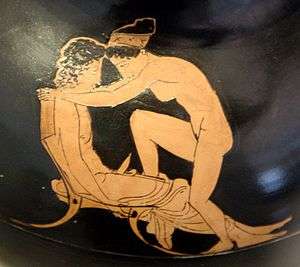 Oinochoe by the Shuvalov Painter, c. 430-420 BC
Oinochoe by the Shuvalov Painter, c. 430-420 BC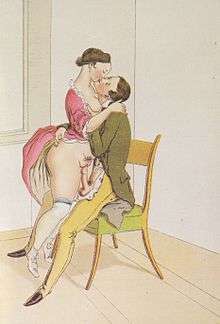 Erotic art by Peter Fendi
Erotic art by Peter Fendi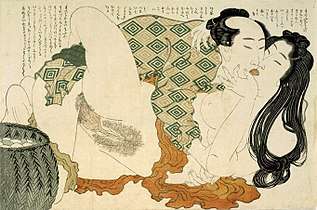 Hokusai, The Adonis Plant (Fukujusō), 1815.
Hokusai, The Adonis Plant (Fukujusō), 1815. Hokusai, The Dream of the Fisherman's Wife, c. 1820.
Hokusai, The Dream of the Fisherman's Wife, c. 1820.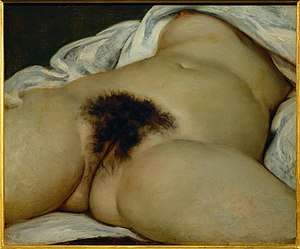 Gustave Courbet, L'Origine du monde, 1866.
Gustave Courbet, L'Origine du monde, 1866.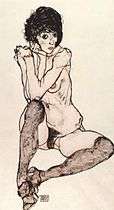 Egon Schiele, untitled nude, 1914.
Egon Schiele, untitled nude, 1914.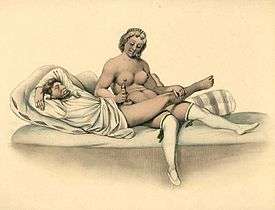 Erotic art by Peter Johann Nepomuk Geiger
Erotic art by Peter Johann Nepomuk Geiger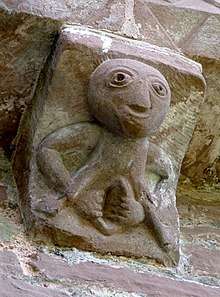 Sheela na Gig at Kilpeck, England.
Sheela na Gig at Kilpeck, England.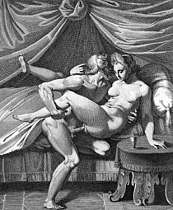 Jupiter et Junon by Agostino Carracci (1557 - 1602).
Jupiter et Junon by Agostino Carracci (1557 - 1602).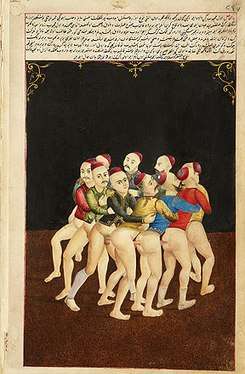 Turkish Erotic Manuscript (1773)
Turkish Erotic Manuscript (1773) Chinese Erotic Art
Chinese Erotic Art.jpg) Édouard-Henri Avril, illustration for Fanny Hill, 1907
Édouard-Henri Avril, illustration for Fanny Hill, 1907 Tantric carving from the Lakshmana Temple, Khajuraho, India
Tantric carving from the Lakshmana Temple, Khajuraho, India
See also
- Blue Movie by Andy Warhol
- Erotic comics
- Erotic fetish art
- Erotic photography
- Erotic pinup art
- Fantastic art
- Golden Age of Porn
- Hentai
- History of erotic depictions
- I Modi
- Lesbian erotica
- Nudity in art
- Pornography
- Pregnancy in art
- Sex in advertising
- Sex in film
- Sexual arousal
- Yiff
- Zazel
- Khajuraho Group of Monuments
References
- ↑ Jacobellis v. Ohio, 378 U.S. 184, 197 (1964).
- 1 2 3 4 5 6 7 8 9 10 Black, Jeremy; Green, Anthony (1992). Gods, Demons and Symbols of Ancient Mesopotamia: An Illustrated Dictionary. The British Museum Press. pp. 150–152. ISBN 0-7141-1705-6.
- ↑ Nemet-Nejat, Karen Rhea (1998). Daily Life in Ancient Mesopotamia. Daily Life. Santa Barbara, California: Greenwood. p. 137. ISBN 978-0313294976.
- 1 2 3 4 5 6 7 Robins, Gay (1993). Women in Ancient Egypt. Cambridge, Massachusetts: Harvard University Press. pp. 189–190. ISBN 0-674-95469-6.
- 1 2 3 4 O'Connor, David (September–October 2001). "Eros in Egypt". Archaeology Odyssey.
- 1 2 3 4 Schmidt, Robert A.; Voss, Barbara L. (2000). Archaeologies of Sexuality. Abingdon-on-Thames, England: Psychology Press. p. 254. ISBN 978-0-415-22366-9.
- ↑ Chambers, M., Leslie, J. & Butts, S. (2005) Pornography: the Secret History of Civilization [DVD], Koch Vision.
- ↑ "Shunga". Japanese art net and architecture users system. 2001. Retrieved 2006-08-23.
- ↑ Bertholet, L. C. P. (1997) "Dreams of Spring: Erotic Art in China," in: Bertholet Collection, Pepin Press (October, 1997) ISBN 90-5496-039-6.
- ↑ Daniélou, A., trans. (1993) The Complete Kama Sutra: the first unabridged modern translation, Inner Traditions. ISBN 0-89281-525-6
- ↑ Igorʹ Semenovich Kon and James Riordan, Sex and Russian Society page 18.
- ↑ Peter Dekkers (6 December 2003). "Het Geheim van Catherina de Grote" [The Secret of Catherine the Great]. Trouw (in Dutch).
- ↑ Woditsch, Peter. "The Secret of Catherine the Great". De Productie. Retrieved 8 July 2014. Includes trailer of the documentary by Peter Woditsch.
- ↑ For an overview, see Eberhard and Phyllis Kronhausen: Erotic Art. Carroll & Graf Publishers, New York 1993, ISBN 0-88184-970-7
- ↑ Alyssa Buffenstein (25 March 2016). "One Sexologist's Quest to Stimulate Las Vegas' Art Scene". The Creators Project.
- ↑ Miller v. California, 413 U.S. 15, 24 (1973).
External links
- "The Erotic Art Market" article from The World's Greatest Erotic Art, Vol.3
- Vintage Fetish Artists, history, bio and art from many old masters
- "Honesterotica", a wide range of erotic illustration from late Victorian to the present day, with biographies, bibliographies, and complete portfolios from each illustrated work.